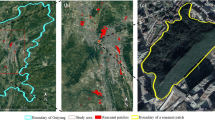Abstract
Although the homegarden systems in the tropics are claimed to sustain basic community needs without environmental deterioration, the ecological rationalities behind the harmony between the humans, homegardens, and the environment are not well understood. Four study sites (Sukhothai, Srisatchanalai, Ayudhaya, and Nonthaburi) representing the four Thai eras in the Chao Phraya Basin were selected for studying these rationalities. The size and physical stature of the homegardens, their plant association and community features, physical environmental factors, nutrient and soil fertility parameters, and cultivation practices were studied. The major factor that determines species selection in homegardens is the utilization of the products, while the various practices within the homegardens are determined by such factors as the species, the system, and the environment. All homegardens had four vertical stratifications, with physical structures almost similar to that of dry dipterocarp forest, but with lower height for each layer, lower diversity of plants, and sparser crown layer. The analysis also shows a high possible utilization efficiency for space, light, water and nutrients in the soil in the homegardens. Shannon-Wiener's indices of species diversity of the homegardens were close to those of dipterocarp forest. The homegardens are in-situ reservoirs for biodiversity at genetic-, species-, and ecological levels. There was no complete harvesting from these homegardens. This practice ensured minimal nutrient export from the systems, while high amounts and diversity of litter biomass should contribute to high efficiency of nutrient cycling. Futhermore, phosphorus availability could be better in homegardens. The homegardens had more favorable microenvironment with lower soil and atmospheric temperature and higher relative humidity than outside. There has been no single incident of a pest outbreak at a threatening level.
Similar content being viewed by others
References
Ahmad AM and Abood F (1990) Selected forest trees with potential application in Malaysian agroforestry. BIOTROP Special Publication No. 39. BIOTROP, Indonesia. 77-89.
Balasubramanian V and Egli A (1986) The role of agroforestry in the farming systems in Rwanda with special reference to the Bgesera-Mingogo region. Agrofor Syst 4: 489-534
Boontawee B, Plengklai C and Khao-sa-ard A (1995) Monitoring and measuring forest biodiversity in Thailand. In: Boyle TJB and Boontawee B (eds) Measuring and monitoring biodiversity in tropical and temperate forests, pp 113-126. CIFRO, Bogor, Indonesia
Bray RH and Kurtz LT (1945) Determination of total organic and available form of phosphorus in soils. Soil Science 59: 39-45
Dumrong, Prince (1907) The Pongsawadan. Department of Fine Arts. Ministry of Education. Bangkok, Thailand (in Thai)
Falanruw MVC (1990) The food production system of the Yap Island. In: Landauer K and Brazil B (eds) Tropical homegardens, pp 94-104. United Nations University Press, Tokyo
Fernandes ECM and Nair PKR (1986) An evaluation of the structure and function of tropical homegardens. Agric Syst 21: 279-310
Fox RL and Kamprath EJ (1970) Phosphate sorption isotherm for evaluating the phosphate requirement of soils. Soil Sci Soc Am J 34: 902-906
Gajaseni J Matta-Machado R and Jordan CF (1995) Diversified agroforestry systems: buffer for biodiversity reserve and landbridge for fragmented habitats in the tropics. In: Szaro R and Johnston DW (eds) Biodiversity in managed landscapes, pp 506-513. Oxford University Press, New York
Gillespie AR Knudson DM and Geilfus F (1993) The structure of four homegardens in the Peten, Guatemala. Agrofor Syst 24: 157-170
Gorman CF (1971) Subsistence patterns in Southeast Asia during the Late Pleistocene and Early Recent period. World Archeology 2: 217-240
Jackson ML (1958) Soil chemical analysis. Prentice Hall, Inc., New Jersey
Jensen M (1993) Productivity and nutrient cycling of a Javanese homegarden. Agrofor Syst 24: 187-201
Jordan CF (1985) Nutrient cycling in tropical forest ecosystems. John Wiley and Sons, Chichester
Jose D and Shanmugaratnam N (1993) Traditional homegardens of Kerala: a sustainable human ecosystem Agrofor Syst 24: 203-213
Karyono (1990) Homegarden in Java:their structure and function. iIn: Landauer K and Brazil M (eds) Tropical homegardens, pp 138-146. United Nations University Press, Tokyo
Krebs, CJ (1985) Ecology: the experimental analysis of distribution and abundance. Harper and Row, Publisher, New York
Landauer K and Brazil M (eds) (1990) Tropical homegardens. United Nations University Press, Tokyo
Makaraphirom P (1989) Check list of species for extension in agroforestry systems. Agroforestry Research 30, Royal Forestry Department, Bangkok, Thailand (in Thai)
Marten GG (ed) (1986) Traditional agriculture in Southeast Asia. Westview Press, Boulder, Colorado
Montagnini FR Gonzales P Rheingans R and Sancho F (1994) Mixed tree plantations in the humid tropics: growth, litterfall and economics of experimental systems in Latin America, pp 125-135. Proceedings of IUFRO Symposium on Growth and Yield of Tropical Forests, Tokyo University of Agriculture and Technology, Fuchu, Tokyo
Ninez V (1987) Household gardens: theoretical and policy considerations. Agric Syst 23: 167-186
Page AL (ed) (1982) Methods of soil analysis. Soil Science Society of America, Inc.
Pelzer KJ (1978) Swidden cultivation in Southeast Asia: historical, ecological, and economic perspectives. In: Kunstadter P Chapman EC and Sabhasri S (eds) Farmers in the forest, pp 271-285. University of Hawaii Press, Honolulu
Richard PW (1952) The tropical rain forest. Cambridge University Press, Cambridge
Sahunalu P Jumruenpruek M Phuriyakorn P Dhammmanond P Suwannaphirom W and Prachaiyo B (1979) Comparative structure of three forest types in Num Phrom basin, Chaiyaphum province. Forestry Research Report 63, Faculty of Forestry, Kasetsart University. Bangkok, Thailand (in Thai)
Sahunalu P Dhammanond P and Phongumphai S (1993) A study on dipterocarp changes. Interim Report to the Research Counsil of Thailand. Research Council of Thailand. Bangkok, Thailand (in Thai)
Torquebiau E (1992) Are tropical agroforestry homegarden sustainable? Agric Ecosystem Environ 41: 189-207
Whitmore TC (1971) Wild fruit trees and some trees of pharmacological potential in the rain forest of Ulu Kelantan. Malayan Nat J 24: 222-224
Whittaker RH (1975) Communities and ecosystems, 2ed. Macmillan Publishing Co., New York
Wojtkowski PA (1993) Toward an understanding of tropical homegardens. Agrofor Syst 24: 215-222
Author information
Authors and Affiliations
Corresponding author
Rights and permissions
About this article
Cite this article
Gajaseni, J., Gajaseni, N. Ecological rationalities of the traditional homegarden system in the Chao Phraya Basin, Thailand. Agroforestry Systems 46, 3–23 (1999). https://doi.org/10.1023/A:1006188504677
Issue Date:
DOI: https://doi.org/10.1023/A:1006188504677




